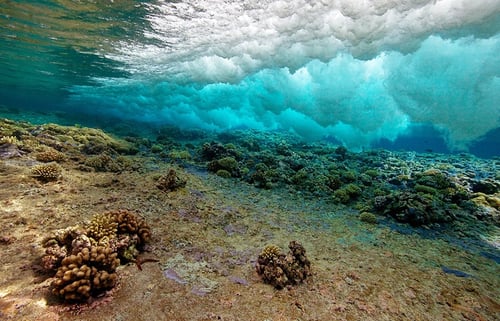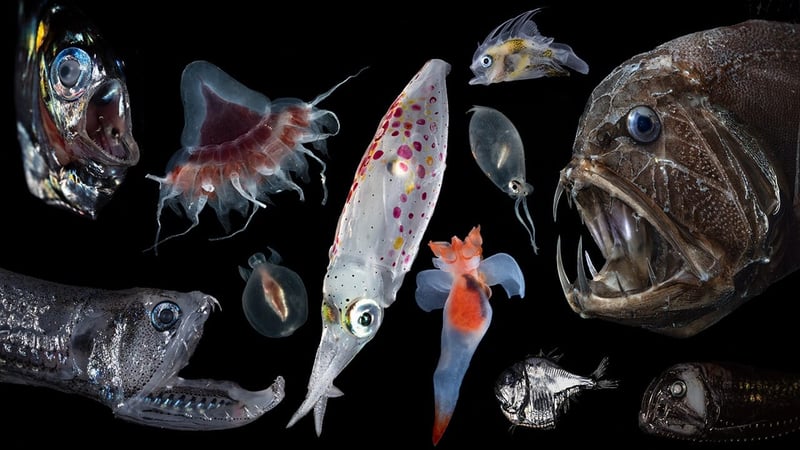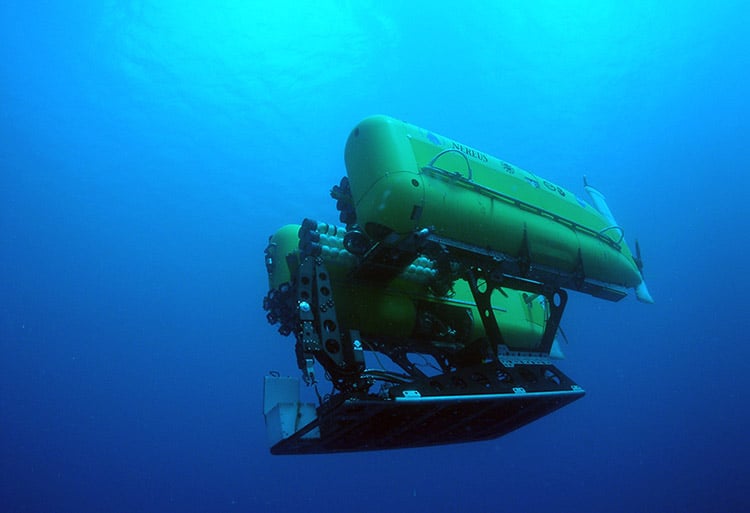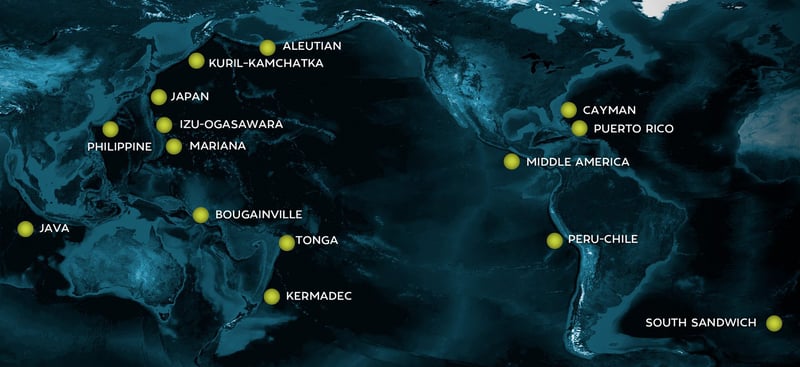The Earth's oceans cover more than 70% of the planet's surface, yet much of their mysterious depths remain unexplored. When describing the ocean, it is useful to break the sea up into regions by levels of depth, from the surface to the bottom. These sections are known as Pelagic Zones. The word pelagic is derived from ancient Greek meaning 'open sea'. Conditions in the ocean change with depth: pressure increases; temperature and light decrease; salinity, oxygen, and micronutrients all change as well. There are five different Pelagic layers encompassing all open waters beyond the coastal regions. Each zone presents unique environments for life on earth, but also challenges for exploration due to their vastness and inaccessibility. The development and utilization of submersibles has revolutionized our understanding of these aquatic realms, and has helped us in unraveling the mysteries of each pelagic zone.
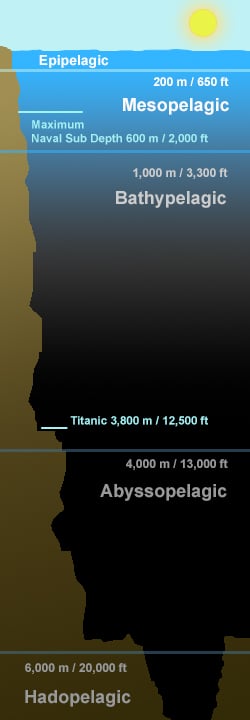
The Ocean Sunlit Zone (Epipelagic zone)
The Sunlit Zone, extending from the ocean's surface to approximately 200 meters, is bathed in sunlight and is the most familiar of the pelagic zones. This zone gets its name from the Greek word for 'over' or 'upper'. This zone supports a wealth of life, from microscopic phytoplankton to large fish species. Submersibles equipped with advanced imaging systems and sampling tools have provided invaluable insights into the diversity and dynamics of this zone.
Within the sunlit zone, phytoplankton, microscopic photosynthetic organisms, form the base of the food chain. They convert sunlight and nutrients into organic matter, sustaining a variety of zooplankton, small invertebrates that drift with ocean currents. These zooplankton serve as a vital food source for larger organisms, including juvenile fish and marine mammals.
In this upper zone of the ocean, water pressure is relatively light, but increases rapidly the deeper you go. In oceanic sciences, pressure is measured in atmospheres (atm). One (1) atm represents the average atmospheric pressure at sea level. Pressure in the ocean rises by one atmosphere (1 atm) for every 10 meters of depth. So at the deepest level of the Epipelagic zone (200 meters below sea level) has the equivalent of 20 atm of water pressing down on them, plus one more from the surface air. As an atm equals about 14.7 pounds per square inch (psi), that's like 308 lbs. of pressure per every square inch.
Autonomous Underwater Vehicles (AUV) such as the Bluefin Artemis 21venture into these sunlit depths and deeper, revealing a rich tapestry of life. They have encountered diverse fish species, ranging from colorful reef fish to migratory tuna and marlin. Additionally, marine mammals such as dolphins and whales frequent these waters, taking advantage of the abundance of food sources. The exploration of the sunlit zone with submersibles has provided crucial data for understanding food webs, migration patterns, and the overall health of marine ecosystems.
The Ocean Twilight Zone (Mesopelagic zone)
The Twilight Zone, spanning from 200 to 1,000 meters, is a mysterious realm where sunlight rapidly diminishes. The meso zone gets its name from the Greek word for 'middle'. Despite the low light levels, this zone teems with life, featuring unique adaptations to survive in the dimly lit environment. Submersibles equipped with specialized lighting systems and sensors have allowed scientists to uncover the secrets of the twilight zone.
Within the twilight zone, bioluminescent organisms are particularly prevalent. These fascinating creatures produce their own light through chemical reactions, which serves various functions, including communication, camouflage, and attracting prey. Lanternfish, for example, exhibit bioluminescent patterns on their bodies, aiding in their ability to blend with the ambient light and avoid predators.
U.S. Navy nuclear-powered submarines such as the Virginia-class and Columbia-class can operate in this zone, down to an estimated depth of around 490 meters (1,600 feet). The U.S. Navy also uses other submersibles in the Undersea Rescue Command (URC) that can dive to an estimated at 600 meters (2,000 feet), in order to conduct open hatch rescue operations on a disabled submarine (DISSUB). The pressure on submersibles at 600 meters is 896 psi, which is like having the weight of a large telephone pole pressing on every inch of your body.
Unmanned Underwater Vehicles (UUV) such as the Hydroid REMUS 6000 have explored the twilight zone and even deeper, capturing captivating footage of bioluminescent organisms. They have encountered deep-sea squids, which possess large, light-emitting organs called photophores. These squids use bioluminescence for communication and predation, creating stunning displays in the depths. Other unique species found in the twilight zone include hatchetfish, viperfish, and various jellyfish species. The exploration of this zone has deepened our understanding of the adaptations and interconnectedness of organisms within the mesopelagic realm.
The Ocean Midnight Zone (Bathypelagic zone)
The Midnight Zone, extending from 1,000 to 4,000 meters, plunges into eternal darkness. The bathyal zone gets its name from the Greek word for 'deep'. The temperatures here approach freezing, and the immense pressure poses challenges for exploration. The crushing pressure, permanent darkness, and vast expanse of the deep ocean zones under 1,000 meters, combine to make it one of the least explored parts of the planet. The pressure in the bathypelagic zone at depths of 4,000 meters (13,100 feet), reaches over 5,850 pounds per square inch. Nonetheless, submersibles designed to withstand extreme conditions have enabled scientists to uncover the secrets of this deep, mysterious zone. The average depth of the ocean is estimated to be about 3,688 meters (12,100 feet), with the seafloor beginning at the bottom of the bathyal zone.
The seafloor is also referred to as the Benthic Zone, which is at the lowest level of a body of water such as an ocean, lake, or stream. The name Benthic comes from ancient Greek meaning "the depths", and organisms living in this zone are called benthos. Compared to the relatively featureless pelagic zones, the benthic region offers physically diverse habitats for marine benthic organisms. The seafloor varies widely in the types of sediment it offers. Burrowing creatures can find protection and food in soft, loose sediments such as mud, clay and sand. Sessile species such as oysters and barnacles can attach themselves securely to hard, rocky substrates. Most food in this zone comes from dead organisms sinking to the bottom of the ocean from overlying waters.
Within the midnight zone, life forms have evolved remarkable adaptations to survive in the harsh environment. This dark ocean environment can also be described as the Aphotic Zone (from the Greek "without light"), as the only light at these depths comes from organisms that possess bioluminescent capabilities. Some of the most notable inhabitants of the midnight zone include sperm whales that venture down here to feed, deep-sea corals, which form intricate and delicate structures on the seafloor, and giant squid- an elusive creature that can grow to tremendous sizes.
In August 2023, scientists at the Monterey Bay Aquarium Research Institute (MBARI) posted some amazing discoveries made over the course of 14 dives with MBARI’s remotely operated vehicle (ROV) Doc Ricketts. MBARI sent the deep ocean robot 10,500 feet (3,200 meters) below the ocean's surface, and found an ''octopus garden'' in the midnight zone. Clustered around a hydrothermal vent, in the warm waters created by an extinct volcano, they documented over 6,000 octopuses living in a six-acre area, including 4,707 females nesting over their eggs. The expect however, that there may be 20,000 or more at this nursery. The rare octopus species is named 'Muusoctopus robustus', commonly known as the 'pearl octopus' due to how they look while protecting their eggs (see image below). While typical water temperature in this section of the Bathypelagic zone is 35 degrees Fahrenheit (1.6 Celsius), the ambient water temperature in the octopus garden reaches around 51 degrees Fahrenheit (11 degrees Celsius).
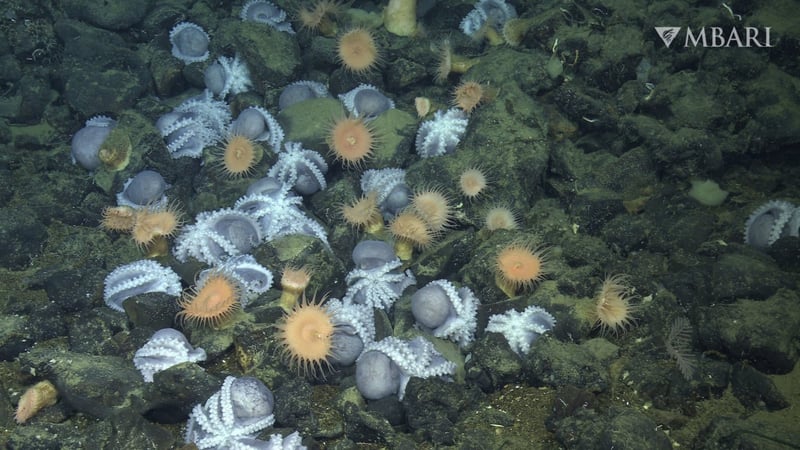
Submersibles such as the Triton 36000 and the Human Occupied Vehicle (HOV) Alvin, have also successfully explored the midnight zone, reaching very deep parts of the ocean. These dives have allowed scientists to observe and document the unique organisms living in this realm. Amphipods, small crustaceans, thrive in the midnight zone, displaying adaptations to high pressures and limited food availability. The exploration of the Bathypelagic zone has uncovered extraordinary adaptations and revealed the interconnectedness of deep-sea ecosystems.
The Ocean Abyssal Zone (Abyssopelagic zone)
The Abyssal Zone, ranging from 4,000 to 6,000 meters, represents the deepest part of the open ocean. The abyssal zone gets its name from the Greek word for 'no bottom', because they thought the ocean was bottomless. This zone includes the Abyssal Plains, which makes up most of the ocean floor. These plains cover more than 50 percent of the Earth’s surface. Like plains on land, the Abyssal Plains are very flat. In fact, this zone is one of the flattest landforms on Earth, and three-quarters of the area of the deep-ocean floor lies in this zone. The ocean floor is also where many tectonic plates meet. When plates slide over, under and against each other it can lead to the formation of seamounts, submarine volcanoes, and deep sea hydrothermal vents.
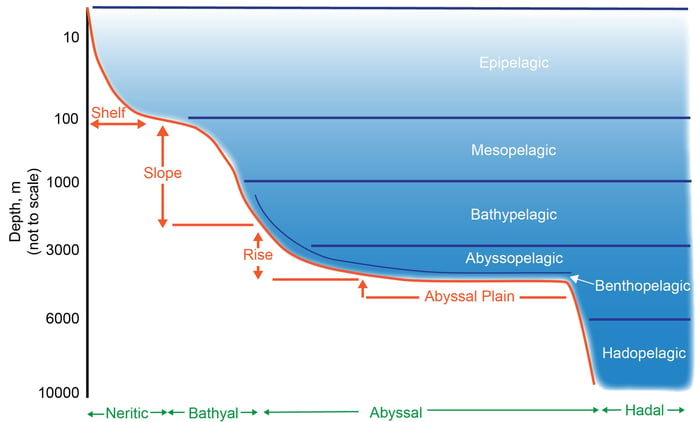
Exploring this zone remains challenging due to the extreme pressures and conditions. Converting the pressure in the abyssal zone from atmospheres, the pressure ranges can reach 8,830 pounds per square inch. However, submersibles equipped with robust hulls and innovative sampling tools have enabled scientists to collect valuable data and samples, unveiling the unique life forms and geological features present in the abyssal zone. Some life at this level grow to gigantic sizes compared to their shallower-water relatives, in a phenomenon known as abyssal gigantism.
Within the abyssal zone, life relies on alternative energy sources, such as chemosynthesis. Hydrothermal vents and cold seeps, found on the seafloor, release mineral-rich fluids, supporting communities of chemosynthetic organisms. These organisms, including tube worms, clams, and shrimp, derive their energy from the chemical reactions occurring around these vent systems.
Submersibles like the Nereus, a hybrid remotely operated vehicle (HROV), and the ISIS ROV, have made significant contributions to the exploration of the abyssal zone. They have discovered new species and revealed the interconnectedness between geological processes and biological communities. The exploration of the abyssal zone has expanded our understanding of deep-sea ecosystems and highlighted their importance in global nutrient cycling.
The Ocean Hadal Zone (Hadopelagic zone)
The Hadal Zone, also known as the hadopelagic zone, is the zone extending beyond the 6,000 meters of the abyssal ocean floor, descending deep within oceanic trenches. This extreme environment poses immense challenges for exploration due to the deadly crushing pressures and pitch-black darkness. It is no wonder the Hadal zone is named after Hades, the Greek god of the underworld. Nonetheless, submersibles designed to withstand these extreme conditions have recently allowed scientists to venture into the abyssal trenches and uncover some secrets of the Hadal Zone.
The Hadal zone includes the deepest recorded point of the explored ocean, known as the Challenger Deep. This area was named after the HMS Challenger, whose crew first sounded the depths of the Mariana Trench in 1875. Challenger Deep is located beneath the western Pacific Ocean in the southern end of the trench, which runs several hundred kilometers southwest of the U.S. territorial island of Guam.
The deep-diving research bathyscaphe named Trieste was the first crewed vessel to reach the bottom of Challenger Deep in 1960. In 2009, a hybrid remotely underwater vehicle (ROV) named Nereus, built by the Woods Hole Oceanographic Institution (WHOI), also explored Challenger Deep. This deepest point of the ocean was confirmed to be 10,935 meters (35,876 feet) deep, by the deep-submergence vehicle (DSV) named 'Limiting Factor', during the Five Deeps Expedition in 2019.
The temperature at Challenger Deep is constant, at just above freezing. The weight of all the water over head in the Mariana Trench creates over 8 tons of pressure per square inch. While this is the deepest recorded depth, it is possible that an even deeper depth may be found in what some still consider a "bottomless ocean".
Global map of Hadal trenches
The Hadal Zone is home to some of the most enigmatic and elusive organisms on Earth. It wasn't until 1948 that scientists were able to prove that any life at all existed below 6,000 meters. These depths however do harbor a wide variety of unique species that have evolved extraordinary adaptations to survive the extreme pressure and scarce food resources. Some notable examples include deep-sea amphipods, which possess a flexible exoskeleton and reduced pigmentation, as well as giant isopods, which exhibit a slow metabolism and robust physiology. The Hadal snailfish can withstand the extreme pressures of the Hadal Zone only by having gelatinous crush-proof bodies, where pressures within their bodies are the same as those outside them.
In 2012, the Canadian filmmaker James Cameron piloted the Deepsea Challenger submersible, and became the first solo explorer to Challenger Deep. He provided valuable insights into the unique life forms thriving in these depths, and captured footage of deep-sea snailfish as well as observing the potential existence of new species. The Deepsea Challenger was designed to withstand the extreme pressures of the Mariana Trench by using syntactic foam that was able to withstand the pressure without crushing or warping. In addition to the Deepsea Challenger submersible, the Jason ROV was also used as part of the expedition to capture footage of Cameron's historic dive and assist in scientific observations. The ROV also used syntactic foam as a buoyancy solution.
The exploration of the Hadal Zone is crucial for understanding the extreme limits of life on Earth and the interconnectedness between the deepest parts of the ocean and the surface ecosystems. Submersibles have facilitated the collection of valuable data and samples, shedding light on the adaptations and ecological processes in this mysterious realm. As technological advancements continue, future explorations of the Hadal Zone hold immense potential for further discoveries and expanding our knowledge of these extreme environments.
The Future of Submersibles
Submersibles have played a pivotal role in the exploration of the pelagic zones. These remarkable machines have allowed scientists to capture unprecedented imagery, collect vital data, and unveil the hidden mysteries of the oceans' depths. From the sunlit Epipelagic Zone's vibrant ecosystems to the extreme conditions of the Hadal Zone, submersibles have expanded our understanding of marine life, adaptations, and ecological processes in each level of the pelagic zones.
By supporting further advancements in submersible technology, we can continue to explore and document the depths of the pelagic zones. These explorations not only contribute to scientific knowledge but also underline the importance of preserving and sustainably managing our precious marine ecosystems. The continued efforts to uncover the secrets of the pelagic zones will shape our understanding of Earth's biodiversity, evolution, and the delicate balance that sustains life in our oceans.
Globe Composite Solutions for Defense, Submersible, and Marine Use
Globe has an exceptional level of Submersible component experience, ranging from design to rapid prototyping, to scalable manufacturing, and all of the critical testing in between. We are committed to manufacturing quality components for a variety of UUV, AUV, ROV, and HOV submersible applications, and are trusted by the U.S. Navy to deliver over 140 parts and components for submarines. Globe's composite parts offer a wide range of attributes, including: Corrosion Resistance, Hydrolytic Stability, Structural Integrity at Extreme Depths, Sealing Ability, Impact & Shock Resistance, Weight Reduction, Radiation Shielding, Vibration/Impact Resistance, and Acoustic & Signature Reduction.
Globe's Engineered Syntactic Systems division (ESS) now also offers extensive submersible buoyancy solutions, structural solutions, and insulation solutions. Buoyancy design and selection are critical to the successful operation of UUV, AUV, ROV, and HOV submersibles. Low-density syntactic materials make undersea vehicles neutrally buoyant, resistant to hydrostatic pressure and able to explore deeper depths for extended periods of time.


